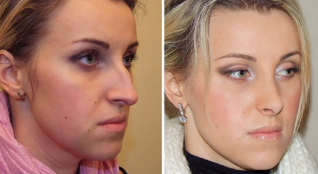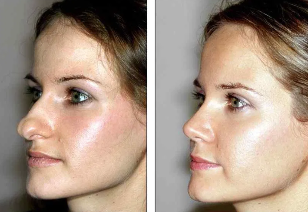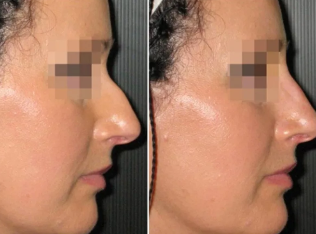Rhinoplasty is one of the most popular operations, which involves the manipulation in the area of the nose. The goal of this procedure to restore the proper shape of the nose, which was cut short due to injuries, diseases or congenital disorders.
The history of the development

Perhaps, you think that rhinoplasty is a recent invention, and the use of the services of the surgeons of the all-star and model. It is not so. The first mention of a technique for the recovery of the nose relates to the antiquity. These steps were carried out in India for 1000 years. c. doctors Indians restored damaged the nose, holding the skin with the cheeks of a patient.
In Europe rhinoplasty has been the development in the middle ages. The Italian surgeons have described their approach to recreate the shape of the nose of the skin of the face. In the 19th century, this type of intervention has received a new development, thanks to the efforts of british and German doctors. There are new techniques based on the experience of indian surgeons.
Initially the appointment of rhinoplasty has been the recovery of damaged nose, cosmetic and aesthetic factors have gained importance already in the late 20th century.
Medical indications for rhinoplasty
Any plastic surgery can be defined as the creative process, and rhinoplasty is not an exception. It combines the solution to the aesthetic problem with the recovery or conservation of the functions of the organ (normal nasal breathing).
In this way, the surgical intervention can pursue both therapeutic and aesthetic goal. Better to do a surgery at the age of 25-30 years, when the cartilage is fully formed. Of course, the recommended age may vary depending on individual circumstances.
Medical indications:
- Violation of nasal breathing, or its complete absence.
- Traumatic injuries that have led to the changes and deformation of cartilage and bone.
- Physiological and movement compensating the deviation of the nasal septum.
- Congenital curvature or deformity of the nasal septum.
- Cysts and polyps in the nose.
- Hypertrophy of the turbinates.
Irregularities in the anatomical structure of the nose lead to different functional complications and pathological entities. This can be: otitis media, rhinosinusitis, bronchial asthma, snoring, frequent respiratory diseases the atrophy or hypertrophy shell nose, difficulty in nasal breathing.
Especially dangerous violation of the nasal breathing children. It can cause lack of oxygen to the brain, which causes mental and physical delays in development. The recovery of respiratory function can be assigned up to 18 years.
Aesthetic indications for rhinoplasty
More than half of the operations to change the shape of the nose is held, for aesthetic reasons. Patients want to achieve harmony in their appearance. Aesthetic indications for the realization of plastic surgery can be divided into two subgroups:
- Objective. When the nose is disproportionate in size, shape.
- Subjective. This sub-group are, first of all, the psychological causes connected with the evaluation of their own appearance. For example, the patient does not like a small hump or upward.
The psychological causes are often associated with the professional or social environment. The patient appear to be complex, a strong dissatisfaction with their appearance.
Aesthetic indications:
- Deviation of the nasal septum.
- Acquired and congenital malformations.
- The disproportionate size compared to the face, when the nose appears too large or too small.
- Saddle-shaped the shape of the nose.
- Hump.
- Too wide nostrils.
- Unpleasant of the form, when the tip forked, rough, cheerful, thickened, or to the tip.
- Asymmetrical nose.
- The correction of the consequences of the failed rhinoplasty.
It is important to understand where the operation is not always possible to obtain a perfect result. In surgery there are no limits, then the rhinoplasty must be perceived as the correction of an existing module.
Contraindications

Before carrying out the operations of many patients, it is recommended that you visit a psychologist. There are cases, when the patient has a normal shape of the nose without aesthetic or functional disorders. Then the problem will be solved after the work with the psychologist.
A plastic surgeon can produce special measures, and to say exactly if there are any defects. There are some parameters, for which it is estimated how the shape of the nose, and the harmony of its provisions with regard to the forehead, the eyes, the mouth, the chin, the ears. On the advice of a doctor, it is possible to simulate the computer of the alleged appearance after the surgery.
Contraindications:
- The limits of age. The operation is not recommended at 18 and after the age of 40. These limits may be removed due to objective reasons.
- Diabetes mellitus, kidney disease, the liver, and the cardiovascular system.
- Folliculitis and acne in the nose area.
- Disorder of coagulation.
- Oncology.
- The mental disease.
- The period of menstruation.
Types of rhinoplasty
Depending on the objectives pursued and the technique of performing a rhinoplasty surgery is divided into different types.
For the goals of rhinoplasty can be:
- Reconstructive. This recovery of the violations that occur because of diseases, injuries, malformations of fetal development.
- Aesthetics. This correction of cosmetic defects.
During the operation can be performed:
- The increase or decrease of the nose.
- The elimination of a small hump.
- Fix the saddle shapes of the nose, which is the removal of depth.
- Correct the shape of the tip of the nose.
- Septoplastike (this correction of the nasal septum).
- The reconstruction of post-traumatic.
According to the method of access to the surgery can be opened and closed. Closed, the method applies when the aesthetic operations, as well as it is less traumatic. In this case, all the cuts are made inside the nasal cavity. The skin is detached from the cartilage and the surgeon can easily adjust the shape, work with the bone tissue and cartilage with a soft cloth, wipe the excess or build with the help of the prosthesis. After handling the cuts gently stored.
Open rhinoplasty is applied in complex cases, the corrections of big changes, and execution of large volume transactions. The incision is made, step by step, on the fold between the wings of the nose. In this case, the surgeon gets a good access to the tissues, cartilage and bones. The healing with this method requires the most time, it remains remarkable postoperative tripe.
Non-surgical rhinoplasty
Non-surgical rhinoplasty – is not an alternative to surgery. However, there are methods that allow you to correct the small defects.
Rhinoplasty with the help of investigators (special cosmetic gel) will help to correct small defects, soften the edges, to restore the symmetry, change the shape of the tip. Application of filler allows you to mask a small hump, remove the falsehood, to round the tip.
The recovery period after this surgery is easier, the cost of the procedure below to complete the operation. However, the effect of the filler persists only for a couple of months (maximum 1.5 years). In some cases, the injection site is formed fibrous tissue, and the effect of the procedure is preserved for years to come. But more often it is necessary to repeat the procedure. There is the risk of complications: a migration inserted the gel, and the change of the structure of tissues with repeated injections.
With the help of injection, it is possible to not only build, but also to remove the fabric. There are drugs based on hormones, which can eliminate the unevenness, convexities and also in some cases of a small hump. With the introduction of these medicines is very important to pay attention to. Often the procedure is carried out in several stages. After 2-3 weeks, it will be visible in direct.
With the help of special wires, it is possible to adjust the shape of the wings of the nose and also pull the toe. Are thread through the puncture, in the place where they can form scars. The filaments can break due to the mobility of the nose. For these reasons, surgeons often use of this procedure.

Preparation for the intervention
For the success of the operation is necessary to the interaction of the patient and the doctor. Before a surgery is held on the consultation, where the surgeon will explain to the patient what is to achieve the desired result.
You carry out common research: analysis of blood, research its coagulation, urine, ECG, HIV test, hepatitis, syphilis.
If necessary, carry out special studies, the picture is taken. If you have a chronic disease, the need for counseling of a therapist or technical profile. The surgery will be postponed in case of acute exacerbation of chronic diseases, occurs in acute respiratory diseases, or infectious lesions of the skin. Before the operation, will be held the interview with the anesthesiologist.
Your doctor may advise you to give up smoking, alcohol, exclude a heavy meal, stop the intake of hypnotics and sedatives. Two weeks before surgery you must stop the intake of aspirin and its analogues.
Complications
Rhinoplasty is one of the most complex operations, as important as it is, and the aesthetic and functional side. Complications occur depending upon various factors not in 4-15% of patients. They can be divided into operative and post-operative.
Operative complications:
- bleeding;
- the retinal breaks in the skin;
- violation of the integrity or fractures of the bones;
- the detachment of the cartilage flap, etc.
Postoperative complications:
- the loss of the sense of smell;
- loss or reduction of sensitivity of the nose and of the lower lip;
- difficulty of nasal breathing;
- atrophic rhinitis;
- the deterioration correct the cosmetics of the scarcity or lack of change;
- psychological complications (the patient does not accept changes in appearance and does not like the new face);
- swelling of the nose and eyelids, the inflammation, the burning;
- the pigmentation of the skin, formation of scars, capillaries in the mesh;
- frequent or prolonged nosebleeds;
- necrosis.
What is the most dangerous complication that can occur during the rhinoplasty is an allergic reaction to the anesthesia. Anaphylactic shock can lead to death in 20% of cases.
The recovery period
The patient can leave the clinic just a few hours after the surgery or remain under observation for the night. Fundamental to the recovery after the correction of the nose has a duration of 3 weeks. Full recovery comes only after six months – a year.
The seams and plaster the Longuet will be removed through 1.5 weeks. Still 2 weeks will not be possible to take a hot bath, rinse with hot water – this can cause bleeding, haematoma, swelling of the face and neck. Need to sleep on your back a reclining. Do not bend, lift weights. In dusty places need to wear a mask.
Within three months they must be carefully protected from shock and pressure on the nose, it is not possible to wear any glasses, masks, heavy headgear. Forbidden the access to the pool and take the sun. The surgeon can install and other limitations of the individual condition of the patient.
The results of the operation
The healing of cartilage and bone tissue, lasts a couple of months. The final result the surgeon and the patient will be able to assess in about 8 months. The decision to do rhinoplasty (especially if they are not too obvious testimony) it can be perceived by others negatively, then the patient should be ready for the ambiguous reaction on the part of relatives and friends.
Relatives may be unhappy with the loss of a family member, or ethnicity devil. However, often the patient himself and his family, are not aware of the particular effect of such an operation, as well as swelling hide the changes, and manifest themselves gradually.
Rhinoplasty is able to completely change the look, but it's not worth to believe, that with the help of plastic surgery is possible without the limits of fashion, all implemented by the imagination. Any operation – what is a threat, can lead to complications and also the deterioration of the defect. So to refer to that intervention must be serious, weighing carefully the potential benefits and the risk of negative consequences.




















